Research is already showing there are gender and age gaps in who is using Generative AI. Survey results from over 50,000 people around the world show that this recent technology is not being evenly adopted by women or across different age groups. Barriers include a lack of training, lack of knowledge, lower media literacy abilities, lack of awareness in Gen. AI’s importance to future job success, lower confidence in Gen. AI skills, lack of a company policy about Gen. AI use, and privacy concerns.
One gender gap in women’s favor relates to senior women in technical functions in the tech industry: they are leading the way in being more likely to be using Gen. AI than their male peers.
This infographic summarizes key statistics about the gender gaps for women:

Below are some of the key findings relating to gender and age gaps for these surveys conducted by academics and organizations. Check out the full reports for additional information and insights.
Generative AI Gap for Women Workers Globally
In the 2024-2025 working paper Global Evidence on Gender Gaps and Generative AI, N.G. Otis, S. Delecourt, K. Cranney, and R. Koning synthesize data from 18 studies (including some below) and other information to show that the gender gap holds across almost all regions and occupations and remains even with equal access to Generative AI.
This supports earlier research showing that globally, women workers are 7-12% less likely to use Gen. AI at work than men, as was found in the Oliver Wyman Forum’s survey of 25,000 working adults in 2023 across the U.S., UK, Canada, Mexico, Brazil, France, Italy, Germany, Spain, China (Hong Kong), India, Indonesia, Singapore, the United Arab Emirates, and Australia (see Figure A).
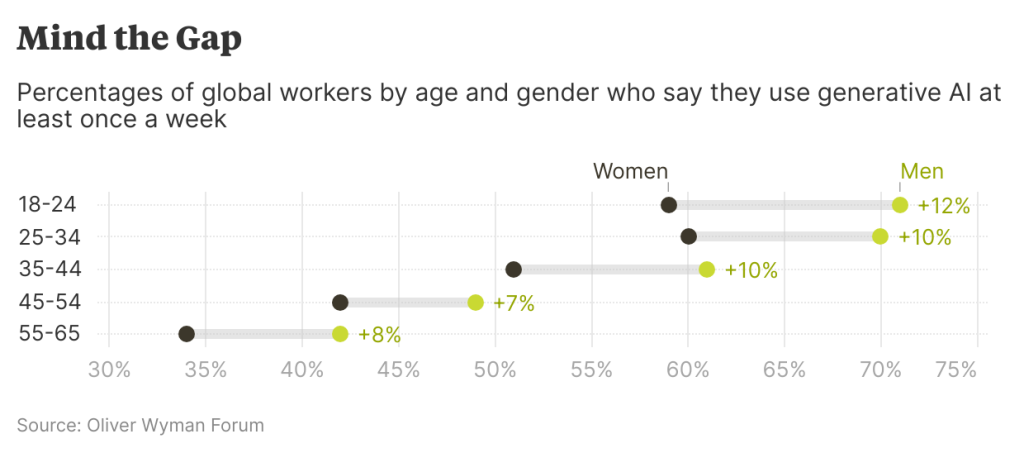
The biggest gap is with women ages 18-24 (12% gap) and the smallest gap is with women ages 45 to 54 (7%). Looking only at women’s usage in terms of age, over 50% of women under 45 are using Gen. AI, compared to around 42% of women ages 45-54 and 34% of women over 55. Looking only at men’s usage, over 60% of men under 45 are using Gen. AI, compared to around 49% of men ages 45-54, and 42% of men over 55.
Gender and age gaps also appear in A. Humlum and E. Westergaard’s study of ChatGPT adoption by 18,000 workers in Denmark across 11 occupations in 2023-2024 (see Figure B) [peer-reviewed article published later here]. The occupations are: Accountants and Auditors, Customer Service Rep, Financial Advisors, HR Professionals, IT Support, Journalists, Legal Professionals, Marketing Professionals, Office Clerks, Software Developers, and Teachers.
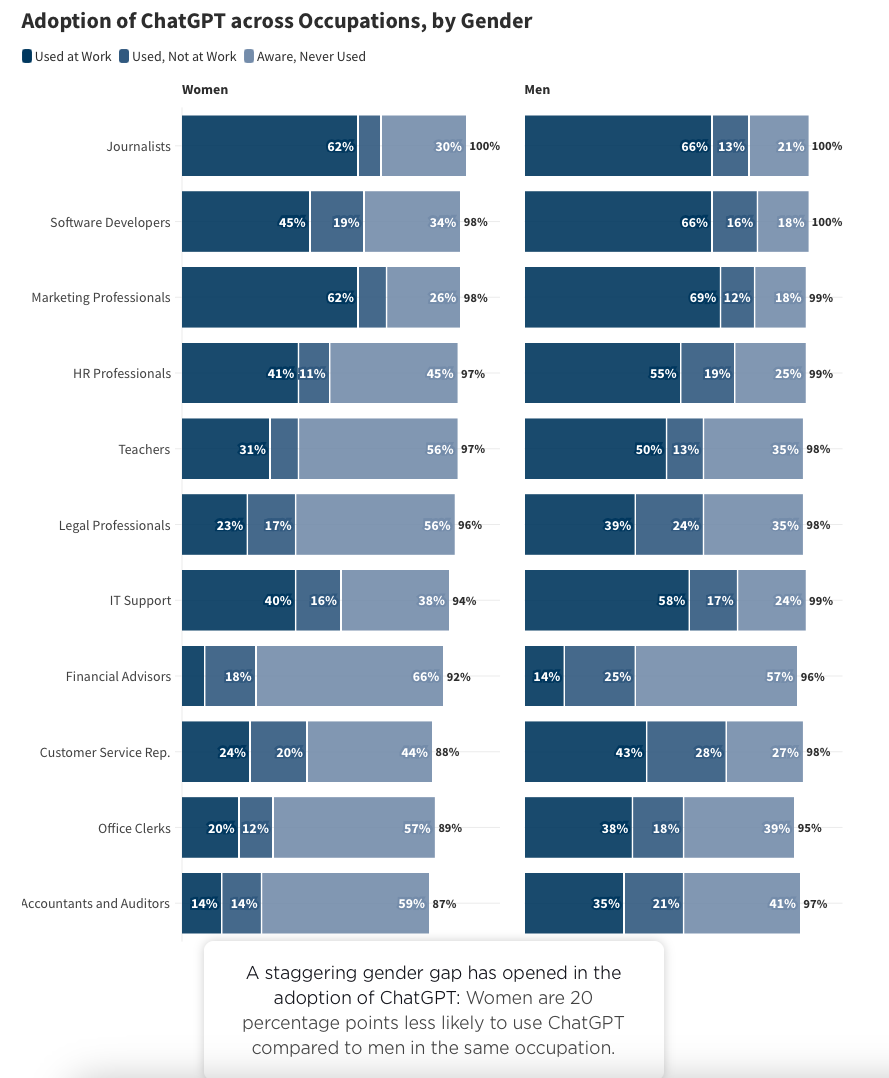
Women workers are 20% less likely to use ChatGPT compared to men in the same occupation. However, women are similarly optimistic about the productivity of ChatGPT. The study’s authors note that the need for training is hindering some women from taking advantage of this tech.
In terms of age, younger workers are more likely to use ChatGPT across all 11 occupations studied (see Figure C). The age gap ranges from 13% to 25%. The authors state that every year of age is associated with a 1.0% lower likelihood of using ChatGPT.

Generative AI Gap for Women in Australia
A study of around 4,400 Australians in Adult Media Literacy In 2024: Australian Attitudes, Experiences And Needs by T. Notley, S. Chambers, S. Park, and M. Dezuanni also shows gender and age gaps in Gen. AI usage (see Figures 6.2 and 6.4).
Women are 12% less likely to have used text-focused Gen. AI and 15% less likely to have used image-focused Gen. AI compared to men. More women than men (43% vs. 32%) say they don’t use Gen. AI because they don’t know what it is. Women are less likely than men (14% vs. 25%) to have a positive sentiment toward Gen. AI, and more likely to have a strongly negative sentiment (25% vs. 17%). The authors state that people’s confidence in their media literacy abilities is strongly associated with them using Gen. AI and having a positive sentiment toward Gen. AI, indicating the importance of media literacy in adapting to this new technological landscape.
In terms of age difference, about a quarter of people ages 18-39 use text-focused Gen. AI regularly, compared to 14% of people in their 40s, 6% of people in their 50s, and 1-3% for those over 60. 26% of people ages 18-29 use image-focused Gen. AI regularly, compared to 16-19% of people in their 30s and 30s, and 7% or fewer of those over 50.
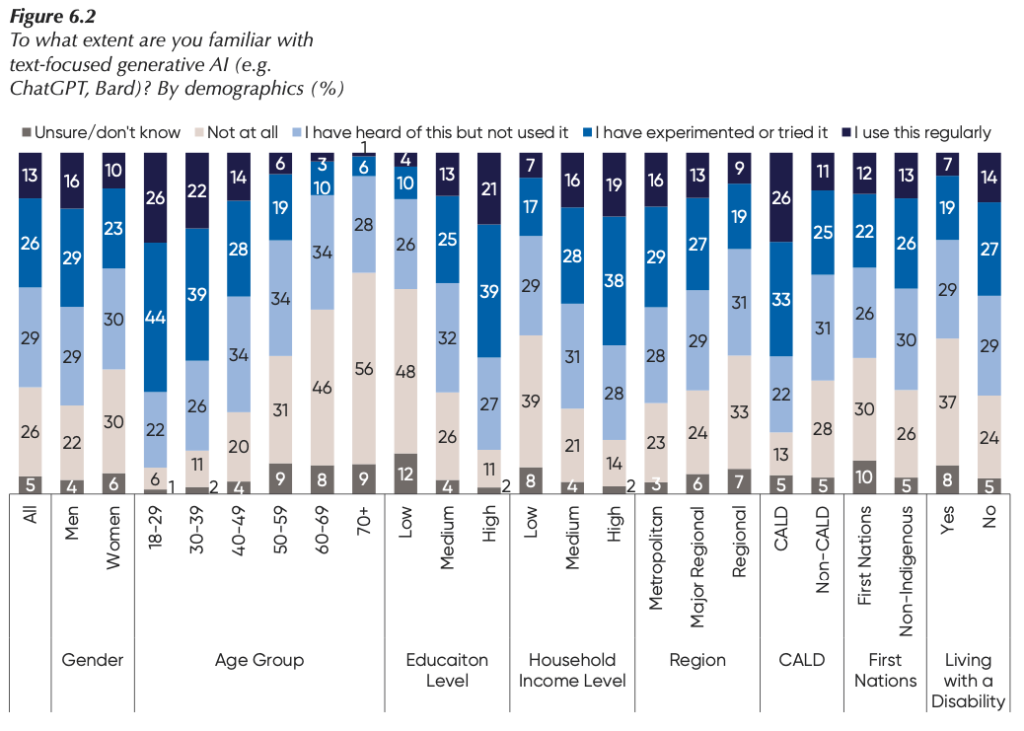

The April 2023 study Young People’s Perception and Use of Generative AI by Youth Insight examines 576 students and young people ages 14-26 in Australian high schools, universities, colleges, and workplaces. It reveals gender and age gaps as well (see Figures D and E).
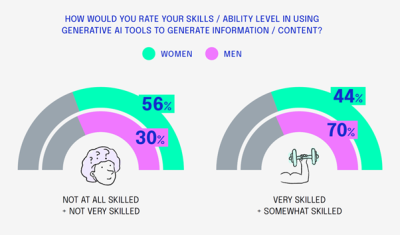
The confidence gap is 18% on average, with 56% of young women reporting confidence in using Gen. AI tools compared to 74% of young men. In terms of skills, young women are more likely to say they aren’t skilled (56%) while young men are more likely to say they are skilled (70%). There is a large 45% gender gap in skill level for students in higher education environments, with only 28% of young women saying they are skilled compared to 73% of young men.

The lower the age group, the more likely young people are to have used a Gen. AI tool. 70% of young people ages 14-17 have used it, compared to 55% of young people ages 23-26.
Generative AI Gap for Women in Tech Industry
In BCG’s 2024 Women in Tech Survey of 6,500 employees in in tech companies in the US, UK, Germany, Japan, and India, gender and seniority gaps in Gen. AI adoption appeared (see Figure F).
Junior women in technical roles were 7% less likely to use Gen. AI, and junior women in nontechnical roles were 21% less likely to use Gen. AI than men. Three key attributes were determined to account for the difference: awareness of Gen. AI’s criticality for future job success, risk tolerance for using Gen. AI without a company policy, and confidence in Gen. AI skills.
However, there was one area where women were more likely to use Gen. AI: senior women in technical roles were 12-16% more likely to use it.
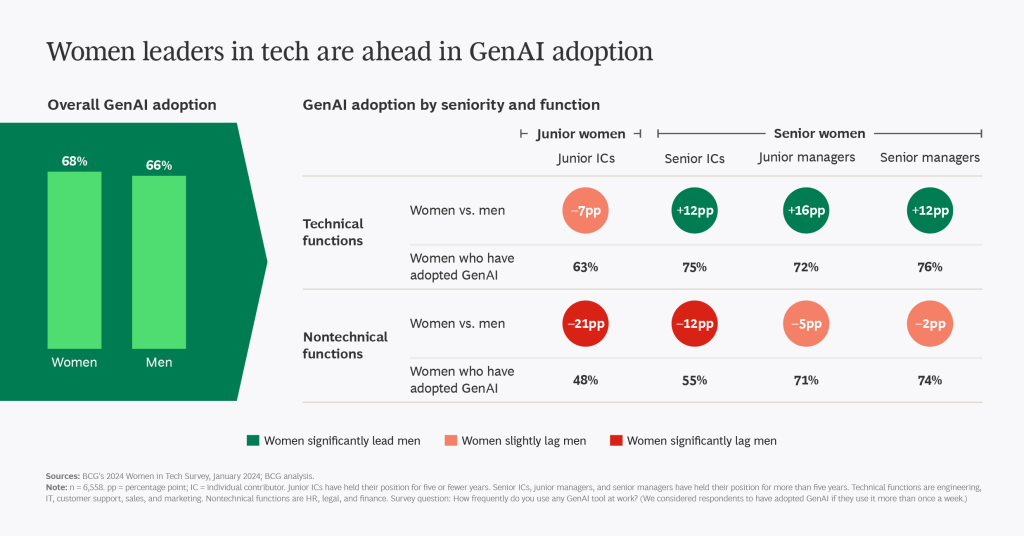
Generative AI Gaps in the US
The Federal Reserve Bank of New York’s Survey of Consumer Expectations added questions about Gen. Ai to its regular survey of around 1,300 U.S. consumers (nationally representative sample of Americans surveyed monthly) in February 2024, of which 890 completed this section. The results were analyzed in the paper The Gen AI Gender Gap by I. Aldasoro et. al [paywalled but working paper available here].
Researchers found an economically and statistically significant gender gap of 13%: 37% of women had used Gen. AI in the past year vs. 50% of men. In addition, 12% of women had used Gen. AI weekly, compared to 19% of men (see Figure A1).

Researchers also noted that men had significantly higher levels of trust and knowledge about Gen. AI, had lower levels of privacy concerns, and saw greater benefits in terms of job opportunities and lower risks with Gen. AI compared to women. Researchers believed that privacy concerns and perceived opportunities and risks can explain a quarter of the gender gap, but that people’s knowledge is the most important factor.
A small survey of 500 parents in the U.S. by HostingAdvice.com found a gender gap in their children’s usage of Gen. AI (see Figure G).

45% of girls ages 7-14 are using AI tools compared to 54% of boys the same age, resulting in a 9% gender gap. Also, of girls who did use AI tools, they were 9% less likely to use it for homework help.
The survey also found a gender difference in parental views on AI for children. Fathers were 19% more likely to want their child to use AI tools like ChatGPT, and mothers were 5% more likely to be undecided about the issue. And the survey found a difference in parents’ attitude about AI tools depending on their child’s gender, with a higher likelihood of supporting AI tools for boys than girls.
Conclusion
The pre-existing gender gap in technology continues on with the uneven uptake of Generative AI technologies by women and men, and early studies are showing that the same trend is happening with girls and young women as well. There are also age gaps that may or may not change depending on how the technology becomes integrated into daily life. It appears that efforts to increase people’s skills and confidence are needed to close these gaps and encourage responsible usage of Generative AI that will not leave people behind.